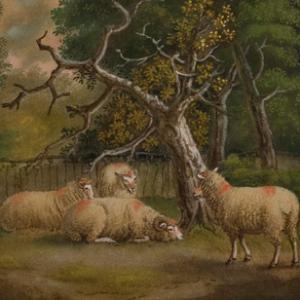Benjamin Zobel began his career in Memmingen in Bavaria (Swabia) in the family confectionery business. This apprenticeship became crucial to his career as a sand-painter. When he turned eighteen he moved to Amsterdam where he stayed for three years studying miniature painting before moving to London, where he was employed by Ecchard Brothers of Chelsea for whom he designed patterned wallpapers, linens and silks. Three years later Benjamin Zobel was employed by the Prince Regent's chef Louis Weltje, and became a`Table Decker' at Windsor Castle. The custom of`Table Decking' had been introduced into England by George III, where the table cloth at dinner was elaborately decorated with designs of coloured sands, marble dust, powdered glass or bread crumbs. Zobel became a skilled confectioner and was entrusted with the pictures made in coloured sugars that decorated the huge tarts served at banquets. The method he employed for making sugar patterns was identical to that which he used to make his sand pictures; that is the sugar, or sand, is shaken through a cut and pleated playing-card. Having converted the ephemeral process of sugar pattern to a permanent form of picture making, and believing that there was a future in it, he continued to make his sand pictures in his spare time. The ancient Japanese skill of bon-kei or`tray picture' was known, but Zobel has the reputation of being the inventor of the sand painting technique, and he was certainly the first to introduce the art to England. The subject matter of Zobel's sand-pictures range from battles and biblical scenes to landscapes and flower pieces, although animals, particularly horses, sheep and pigs held a particular fascination for him. His compositions were often taken from the paintings of his dear friend, George Morland. Zobel constructed his images with painstaking precision and was careful to describe every detail and texture, from the soft fur of a tiger to the rough, dusty ground of the farmyard. His works are rare and not often signed in full.
111 PORTOBELLO ROAD,
KENSINGTON,
LONDON,
W11 2QB
FRIDAY, SATURDAY & SUNDAY ONLY
7AM TO 5.30PM - SAT
11AM TO 4PM - FRI & SUN
T: +44 (0)7831 561042
Email: info@walpoleantiques.com

